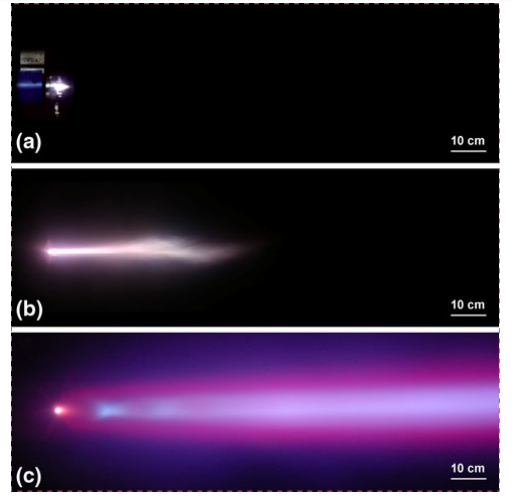Plasma spray-physical vapor deposition (PS-PVD) is a low pressure plasma spray technology recently developed by Sulzer Metco AG (Switzerland). Even though it is a thermal spray process, it can deposit coatings out of the vapor phase. The basis of PS-PVD is the low pressure plasma spraying (LPPS) technology that has been well established in industry for several years. In comparison to conventional vacuum plasma spraying (VPS) or low pressure plasma spraying (LPPS), the new proposed process uses a high energy plasma gun operated at a reduced work pressure of 0.1 kPa (1 mbar). Owing to the high energy plasma and further reduced work pressure, PS-PVD is able to deposit a coating not only by melting the feed stock material which builds up a layer from liquid splats but also by vaporizing the injected material. Therefore, the PS-PVD process fifills the gap between the conventional physical vapor deposition (PVD) technologies and standard thermal spray processes. The possibility to vaporize feedstock material and to produce layers out of the vapor phase results in new and unique coating microstructures. The properties of such coatings are superior to those of thermal spray and electron beam-physical vapor deposition (EB-PVD) coatings. In contrast to EB-PVD, PS-PVD incorporates the vaporized coating material into a supersonic plasma plume. Owing to the forced gas stream of the plasma jet, complex shaped parts such as multi-airfoil turbine vanes can be coated with columnar thermal barrier coatings using PS-PVD. Even shadowed areas and areas which are not in the line of sight of the coating source can be coated homogeneously. This article reports on the progress made by Sulzer Metco in developing a thermal spray process to produce coatings out of the vapor phase. Columnar thermal barrier coatings made of Yttria-stabilized Zircona (YSZ) are optimized to serve in a turbine engine. This process includes not only preferable coating properties such as strain tolerance and erosion resistance but also the simultaneous coverage of multiple air foils.
Keywords ceramic oxide layers, coatings for gas turbine components, low pressure plasma spray
Introduction
A common feature of the thermal spray processes is that the coating build-up is performed by a spray of molten or semi-molten coating material. Conventional vacuum plasma spray processes usually operate at pressures above 3 kPa (30 mbar) (Ref 1). In contrast to thermal spray technology, the working pressure of physical vapor deposition (PVD) processes is much lower and can vary from 5 Pa (5 9 10 2 mbar) to 0.1 Pa (1 9 10 3 mbar), and sometimes even lower (Ref 2-4). With PVD, the coating material condenses directly on the substrate out of a vapor cloud. This enables us to produce coatings with characteristics which are not yet achievable with any of the existing thermal spray processes. PVD coatings are very homogeneous, thin, dense, hard, gas tight, and have specially designed microstructures. ForThe challenge taken by Sulzer Metco in this domain is to combine the advantages of thermal spraying, namely, the high coating quality, high deposition rates, and low investment costs with the possibility to produce coatings out of the vapor phase using plasma spray technology. This would afford a main advantage in the coating performance and would expand the fifield of application of thermal spray by opening up a whole new market and future growth perspective. From this point of view, Sulzer Metco has been successful in modifying a standard low pressure plasma spray

上一篇: 氮化镓基晶体管
下一篇: 二氧化钛薄膜的结构和光学研究